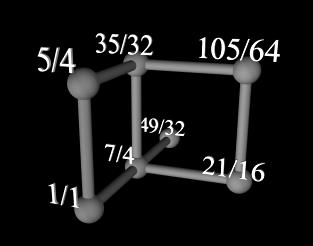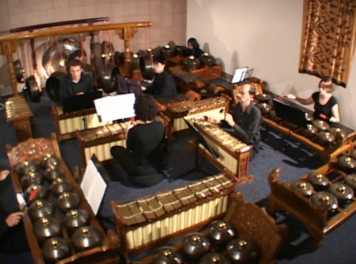
Schneider's Vogt guitar fretted for the performance of Harrison's In Honor of the Divine Mr. Handel
Harrison was most interested in creating American gamelan tuned in just intonation versions of pelog and slendro. When I was studying this music in Java, I commissioned instruments tuned to my own just intonation versions of pelog and slendro. (The story of this process and the tunings can be found here.) This set of instruments turned into the HMC American Gamelan, which was used to record John Schneider's version of Harrison's In Honor of the Divine Mr. Handel for guitar and gamelan. This piece uses the pelog tuning system (although Harrison cleverly uses pelog in such a way as to suggest Handel's diatonicism). The tuning of the pelog of the HMC American Gamelan is as follows (although the pitch shown as D here is actually the Javanese pitch 1, and Harrison's piece has a tonic of F):
| Pitch | C | D | E | F | G | A | Bb | C | |||||||
| Ratio from 1/1 | 1/1 | 35/32 | 5/4 | 21/16 | 49/32 | 105/64 | 7/4 | 2/1 | |||||||
| Cents from 1/1 | 0 | 155.1 | 386.3 | 470.8 | 737.7 | 857.1 | 968.8 | 1200 | |||||||
| Frequency | 268.2 | 293.3 | 335.2 | 352 | 410.7 | 440 | 469.3 | 536.4 | |||||||
| Ratio between pitches | 35/32 | 8/7 | 21/20 | 7/6 | 15/14 | 16/15 | 8/7 | ||||||||
| Cents between pitches | 155.1 | 231.2 | 84.5 | 266.9 | 119.4 | 111.7 | 231.2 |
In the following lattice diagram, the pitches of the scale are shown as spheres, and relationships between them are represented by their relative positions. A ratio of 3/2 is shown as a line connecting the two pitches from left to right (right to left would equivalently be a 4/3). A line extending up from a pitch means that the upper pitch is a 5/4 higher (again, going down would equivalently represent an 8/5). A line going from front to back indicates a ratio of 7/4 (8/7 going back to front):

Just as pelog does not exist in a single standard form in Java, so Harrison's gamelan works can be well represented on different pelog scales (although, of course, Harrison had a preference for just intonation versions of pelog). The original version of In Honor of the Divine Mr. Handel was recorded with harp and the gamelan built by Harrison and Colvig, named "Si Betty" (in honor of their patron Betty Freeman, whose donation funded its construction). Si Betty's pelog is based on harmonics 12, 13, 14, 17, 18, 19, and 21. If we arrange these numbers as ratios and modulate to make pitch 7 (C) our 1/1 (so as to allow comparison with the above table), the result is: 1/1, 8/7, 26/21, 4/3, 34/21, 12/7, and 38/21.
